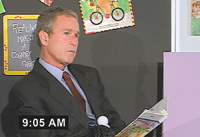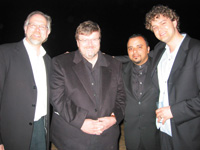
Ken McGorry
|
NEW YORK - By July 20th, director Michael Moore's Fahrenheit 9/11 production team was ready for a breather. Work on Fahrenheit had rocked along at a frantic pace right up to the film's debut and through it all the team worked almost like a newsgathering organization, according to editor/co-producer Kurt Engfehr, who is himself an alum of MSNBC. Even as current events surrounding the Bush Administration's prosecution of the Iraq war continued to roil, Moore and company worked practically 24/7 toward their Cannes debut, followed by the domestic theatrical release in late June and then the just-finished DVD version, planned for release, as producer Jim Czarnecki phrases it, "one month before election day." Each iteration required changes.
The controversial Moore, fresh from his Oscar win for Bowling for Columbine, took the Golden Palm at Cannes for Fahrenheit and went on to see his $6 million film's box office receipts soar well over $100 million with international release.
According to Czarnecki and Engfehr, the film's success is due primarily to Moore's creative ingenuity combined with the team's gargantuan collection of archival material and film-quality original segments shot in HD. They edited in-house at Moore's Dog Eat Dog Films on a rented array of four SD Avids connected to a Unity server. Final post work was done in HD under the technical direction of freelancer Joe Bierne at NYC's Rhinoceros by Avid DS Nitris onliner Craig Gordon with da Vinci 2K color correction by Walt Lefler.

President Bush, after learning the nation was under attack: 9/11s footage ranges from HD and film to off-air TiVo clips.
|
Moore and company accepted fresh video footage from freelance pros as far afield as war-torn Iraq (typically shooting in PAL) and shot key interview segments domestically, mostly in HD with Moore as interlocutor. One highly-charged segment was shot by DP Mike Desjarlais on a Sony 950 HDCAM in Moore's own hometown of Flint, MI. Here the audience witnesses self-described patriot Lila Lipscomb's reaction to her serviceman son's death in Iraq.
Czarnecki and Engfehr agree that one important decision governing the film's impact was to let the pictures tell the story. The producers accepted relevant footage in every imaginable format, new and old, from digital video to archival film to TiVo'd off-air news reports and mightily-compressed Internet footage. Carl Deal was the producer in charge of all the archival footage.
Since Engfehr and fellow Avid editors Woody Richman and Chris Seward offlined at a 15:1 compression ratio to accommodate the ceiling-high stacks of raw footage, the team did not at first know if certain shots would survive the blow-up to 35mm or even to HD. Czarnecki cites footage of an Iraqi grandmother wailing to Allah in front of her bombed house as an example of compelling DV footage that at first suffered from moiré patterns when blown up to film for showing at Cannes. In the domestic release there is no such video degradation visible. Czarnecki says, "After Cannes we got it to look just right."
PUTTING IT TOGETHER
According to TD Bierne, of Exploded Diagram (www.xpldddgrm.com/), Fahrenheit suffered no instances when a clip Moore desired did not make it into the film. Part of his job was to find ways to make a compelling clip work in a movie theatre, including stuff like George W. Bush's playful Oval Office prep prior to his televised announcement of the Iraq war in 2003. That "footage" was actually downloaded off the Internet at 320x240 12fps. It took "a lot of massaging," Bierne says, more than "just putting video images through a box." The boxes included Viacom Video Services' Teranex standards converter and two Snell & Wilcox Alchemist converters at Ranko Gak's GRX in NYC.
Engfehr says the Avid Unity was filled with 1,000 hours of compressed video material. "We had so much footage," Czarnecki says, "Unity saved our ass! Every day we were changing the structure of the story [while] whittling it down to two hours. The cut was at four hours for a long time."

Michael Moore (second from left) flanked by his editors (L-R) Kurt Engfer, Woody T. Richman and Chris Seward.
|
The film was offlined in sections, "a brilliant idea of Michael's," Czarnecki says, "because it completely coincided with the way he works - he organized the story with big note cards." Engfehr says his offline work is mostly seen in the first third of the film, including footage of President Bush's reaction to initial reports of the Al Queda's 9/11 attacks on the World Trade Center.
Bierne agrees with Czarnecki and Engfehr that one saving grace of the Fahrenheit experience was that TV news and ENG footage could and should look just like what it is and not appear too pristine. Though the conforming process alone was formidable, Bierne coordinated it all, including the video footage's journey from 25fps PAL or 30fps NTSC to its ultimate residence on 35mm film. TDI in LA received a D-5 digital intermediate master for final transfer to film on the Arrilaser recorder.
"It's like weaving a collage," Czarnecki says. "It always fits together because of [Michael's] storytelling ability. No one's ever saying, 'Oh, there's so many different sources of material!'"